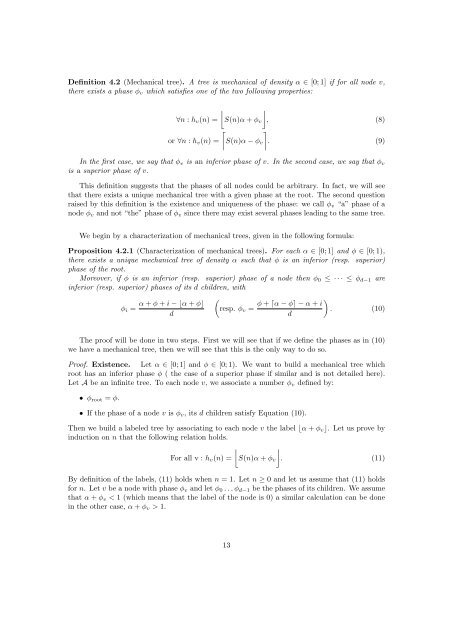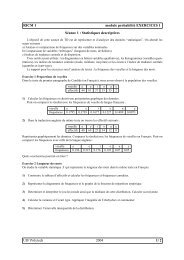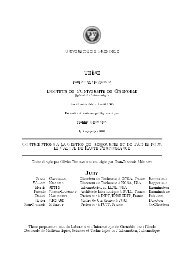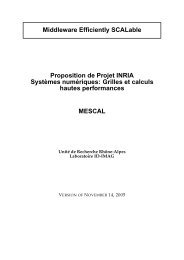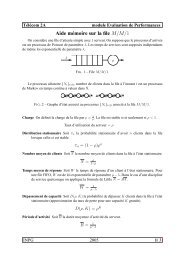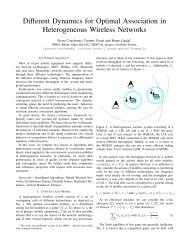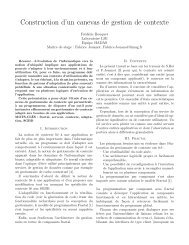Distributing labels on infinite trees
Distributing labels on infinite trees
Distributing labels on infinite trees
You also want an ePaper? Increase the reach of your titles
YUMPU automatically turns print PDFs into web optimized ePapers that Google loves.
Definiti<strong>on</strong> 4.2 (Mechanical tree). A tree is mechanical of density α ∈ [0; 1] if for all node v,there exists a phase φ v which satisfies <strong>on</strong>e of the two following properties:⌋∀n : h v (n) =⌊S(n)α + φ v , (8)⌉or ∀n : h v (n) =⌈S(n)α − φ v . (9)In the first case, we say that φ v is an inferior phase of v. In the sec<strong>on</strong>d case, we say that φ vis a superior phase of v.This definiti<strong>on</strong> suggests that the phases of all nodes could be arbitrary. In fact, we will seethat there exists a unique mechanical tree with a given phase at the root. The sec<strong>on</strong>d questi<strong>on</strong>raised by this definiti<strong>on</strong> is the existence and uniqueness of the phase: we call φ v “a” phase of anode φ v and not “the” phase of φ v since there may exist several phases leading to the same tree.We begin by a characterizati<strong>on</strong> of mechanical <strong>trees</strong>, given in the following formula:Propositi<strong>on</strong> 4.2.1 (Characterizati<strong>on</strong> of mechanical <strong>trees</strong>). For each α ∈ [0; 1] and φ ∈ [0; 1),there exists a unique mechanical tree of density α such that φ is an inferior (resp. superior)phase of the root.Moreover, if φ is an inferior (resp. superior) phase of a node then φ 0 ≤ · · · ≤ φ d−1 areinferior (resp. superior) phases of its d children, withφ i =α + φ + i − ⌊α + φ⌋d(resp. φ v =)φ + ⌈α − φ⌉ − α + i. (10)dThe proof will be d<strong>on</strong>e in two steps. First we will see that if we define the phases as in (10)we have a mechanical tree, then we will see that this is the <strong>on</strong>ly way to do so.Proof. Existence. Let α ∈ [0; 1] and φ ∈ [0; 1). We want to build a mechanical tree whichroot has an inferior phase φ ( the case of a superior phase if similar and is not detailed here).Let A be an <strong>infinite</strong> tree. To each node v, we associate a number φ v defined by:• φ root = φ.• If the phase of a node v is φ v , its d children satisfy Equati<strong>on</strong> (10).Then we build a labeled tree by associating to each node v the label ⌊α + φ v ⌋. Let us prove byinducti<strong>on</strong> <strong>on</strong> n that the following relati<strong>on</strong> holds.⌋For all v : h v (n) =⌊S(n)α + φ v . (11)By definiti<strong>on</strong> of the <str<strong>on</strong>g>labels</str<strong>on</strong>g>, (11) holds when n = 1. Let n ≥ 0 and let us assume that (11) holdsfor n. Let v be a node with phase φ v and let φ 0 . . . φ d−1 be the phases of its children. We assumethat α + φ v < 1 (which means that the label of the node is 0) a similar calculati<strong>on</strong> can be d<strong>on</strong>ein the other case, α + φ v > 1.13


